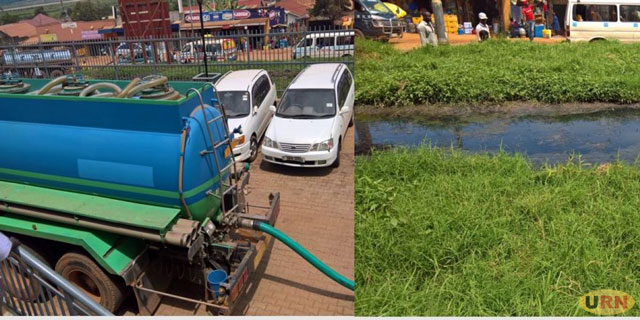
NEWS ANALYSIS | THE INDEPENDENT | A looming sewage management crisis threatens to overshadow growing sanitation facilities in rapidly developing townships and urban regions in Uganda.
This challenge is shared by many living in urban areas, including Mary Mukasa from Mukono, who grapples with the management of her septic tank. The absence of a proper sewage system in her area, coupled with a burgeoning population and the absence of a fecal management facility, exacerbates the situation.
Mukasa says the solution lies in a non-sewered sanitation chain, involving the emptying of latrines and septic tanks. However, a significant challenge arises from the fact that the nearest fecal sludge management plant is located 35 kilometers away in Lubigi, Kampala.
“The trucks charge a hefty 200,000 shillings per trip they make, and even then, you might have to wait for days before one is available.” Mary Mukasa noted.
Jafari Matovu, President of Uganda Emptiers Ltd and a communication and information officer of the Pan-African Sanitation Actors network, explains that the cost of emptying septic tanks soars due to the extended distances their trucks have to travel and the traffic congestion on the route from Mukono to Lubigi.
Matovu also highlighted the reluctance of service providers to operate beyond the borders of Kampala.
This reluctance is driven by the absence of suitable locations for fecal sludge treatment and disposal, along with the considerable distances.
“In the outlying areas, many residents who cannot afford the expensive septic tank trucks opt for manual emptying and dispose of the contents in nearby open spaces and wetlands. This practice persists despite the efforts of Town Councils to prevent such occurrences, underscoring the pressing need for a solution to the sewage crisis,” Matovu added.
The issue is not confined to Mukono alone; Eng. Felix Twinomucunguzi, the Assistant Commissioner of the Sewerage Sanitation Division in the Ministry of Water and Environment’s Urban Department, emphasizes that numerous fast-growing townships are wrestling with the same predicament.
To illustrate the gravity of the situation, Eng. Twinomucunguzi cited a specific example involving companies operating in the oil sector in the Buliisa area. These companies found themselves compelled to transport their waste over considerable distances of nearly 300 km to Lubigi for proper disposal.
He raised a pertinent question regarding the state of sewage management in the various townships and urban centers along the route from Hoima, Masindi, Kiryandongo, Kagadi, and others. He then provided an answer, pointing out that very few can afford to transport the sludge all the way to Kampala due to the significant expenses involved, and the current lack of infrastructure.
However, he did offer a glimmer of hope by mentioning that the government is presently working on establishing treatment plants in the oil-rich areas. Yet, a question still lingers – what about the other areas that are not part of the immediate oil-rich regions?
Twinomucunguzi added that to address the matter, the ministry has assessed and grouped several small towns into 50 clusters to facilitate delivery of fecal sludge treatment infrastructure and collection services based on likely increased demand and reduced haulage distances.
The assistant commissioner further added that as the government looks for funds to ensure that each township has its own facility, the regional clusters will be critical to handle the problem at hand.
Twinomucunguzi made the remarks at an event where the Global Green Growth Institute together with Korea International Cooperation Agency were launching Fecal Sludge Treatment Facility Feasibility Study and Designs for a facility to be set up in Mukono municipality.
With the completion of the feasibility study, Mukono is now on track to establish its own fecal sludge treatment facility. According to the study conducted by Fichtner, this facility is anticipated to have a total treatment capacity of 400m3 per day and can be implemented in two phases at a cost of 37.7 billion Shillings.
The study further showed that the facility will necessitate an annual operating cost of 477.6 million shillings, while it has the potential to generate annual revenues of 588.9 million shillings from sources like biogas and irrigation water.
While there is a potential for the facility to generate electricity, the feasibility study suggested that it may not be a viable option. This is due to the possibility that it could be an expensive venture with little economic sense upon completion.
However, Mukono Municipality Mayor, Erisa Mukasa Nkoyoyo, cast a sobering perspective on the situation. He points out that while the vision of a functioning treatment facility is on the horizon, the district is grappling with the significant challenge of securing the designated land for the facility.
“Acquiring the land where the project is remains a considerable hurdle, let alone the task of securing the necessary funds to bring the project to fruition. We needed this kind of project yesterday. The problem is real and becoming big as the population expands. but this (feasibility study) is at least a step in the right direction,” Nkoyoyo said.
Meanwhile, Mary Oyuru, the Principal Engineer at National Water and Sewage Corporation, underscores a crucial aspect of tackling fecal waste management. She emphasizes that the ultimate solution lies in connecting households in townships to sewer lines.
Oyuru further emphasized that her proposed solution necessitates forward-thinking urban planning, specifically involving the integration of treatment facilities and sewage networks in the physical development of new townships.
She stressed that this approach is indispensable to ensure preparedness for the future and to proactively mitigate the recurrence of sewage management challenges as urban areas expand.
***
URN
 The Independent Uganda: You get the Truth we Pay the Price
The Independent Uganda: You get the Truth we Pay the Price


